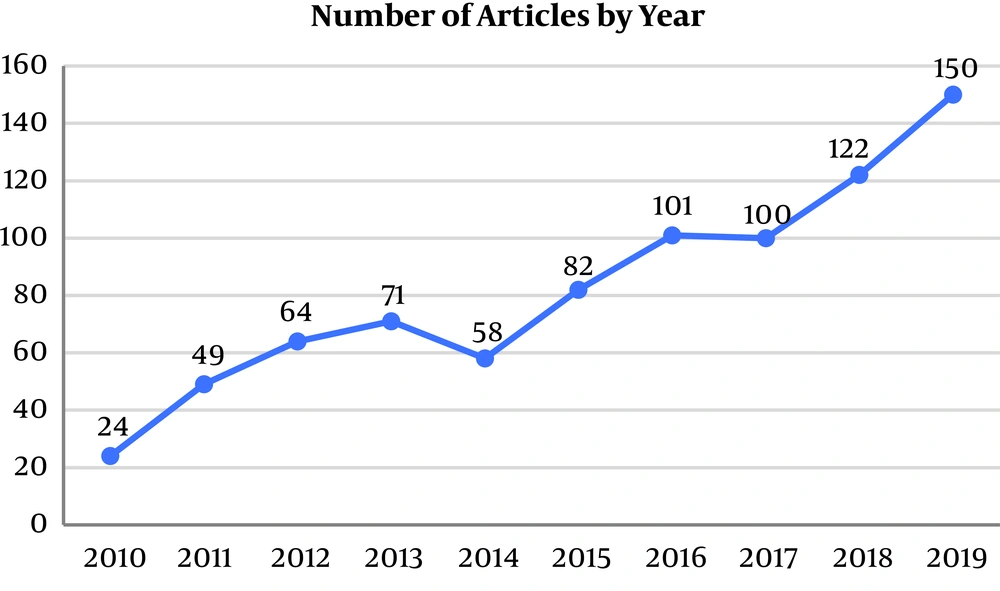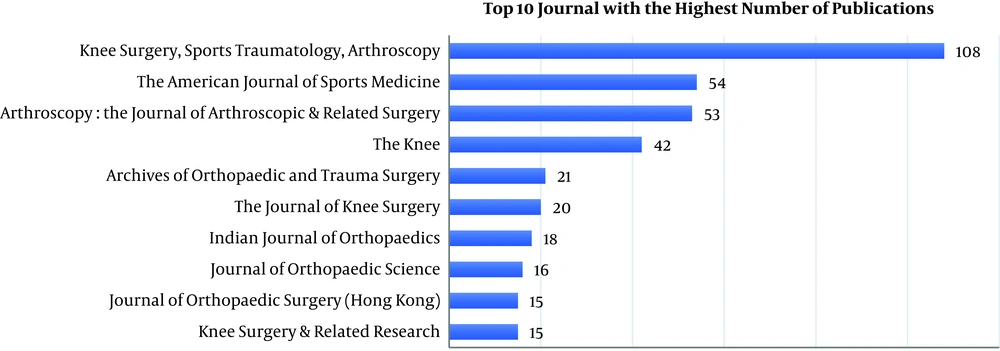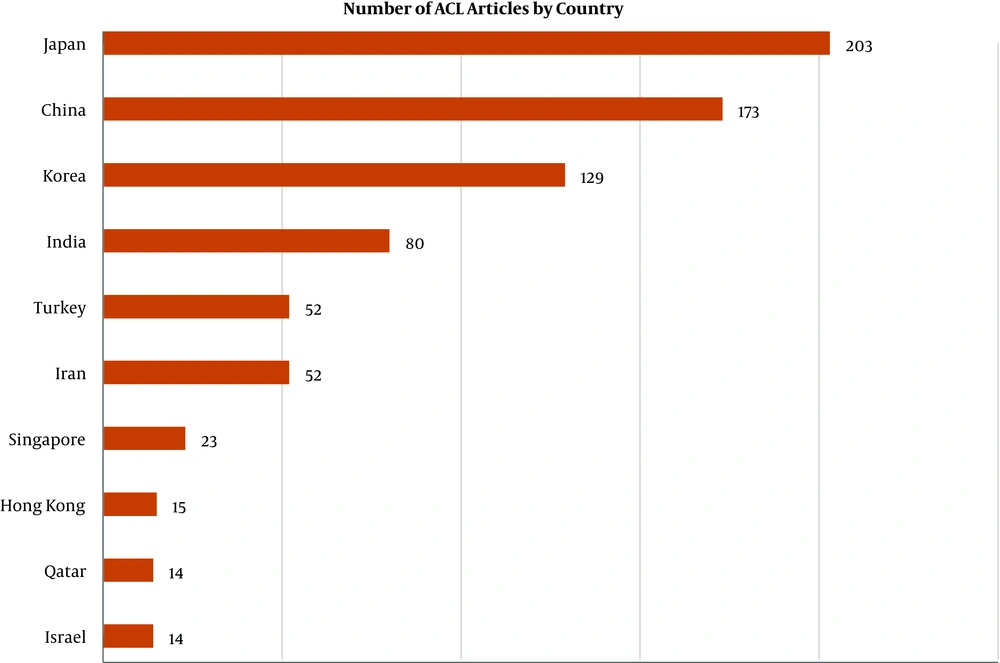1. Background
There have been numerous researches about the anterior cruciate ligament (ACL). The ACL is discussed among knee surgeons because it is the most common injured of the knee ligaments (1). Researchers have attempted to provide the evidence in diagnosis, treatment, prevention, prognosis, and rehabilitation techniques in ACL injured patient (2, 3). The increase in ACL studies has been caused by the development of ACL reconstruction equipment, cadaver dissection tools, and imaging modalities (4).
The publications trends about this ligament have increased by year around the world. There have been 2 studies about systematic reviews in the ACL scope (2, 5), but there still no publication that provides all data about ACL publications, especially in Asian countries. Organizing information in an effective way mandates the use of the best evidence for decision making in ACL care holistically.
Not only in America and Europe, but also in Asia is developing the treatment and diagnosis of ACL injury, and also all about the ACL itself.
2. Objectives
This study wants to provide the publication about ACL in Asian countries in the last 10 years.
3. Methods
We searched in PubMed, EMBASE, and Cochrane Library using the keywords “ACL” OR “Anterior Cruciate Ligament” AND “injury” OR “tear” OR “rupture”. We added English full text and 10 years publications in the filter searching engine. The search resulted in a total of 55.702 articles from 2009 until 2019. We included the articles that discussed the anterior cruciate ligament and at least one author with the affiliation country in Asia. All original articles, including molecular study, laboratory study, animal study, cadaveric study, imaging study, clinical study, systematic review, review article, and other studies that were published between January 1st, 2010 until December 31st, 2019, were included. We excluded the book sections, conference presentations, guidelines, commentaries, or personal reviews. The PRISMA guidelines for conducting the review were followed (Figure 1) (6).
All abstracts were screened independently by two reviewers to determine whether it met eligibility criteria. The full articles of eligible studies were reviewed and included in the study for further data extraction and analysis. We analyzed the number of published articles by year, top 10 journals with the highest number of publications, top 10 authors with highest number of published articles in the first order author, top 10 countries with the highest number of published articles, the most cited articles, and type of study. The published journals were divided by impact factor (IF) into low (IF below 1) and high (IF of 1 and above) impact journals. Information of a country was collected. Data was analyzed using Microsoft Excel and SPSS version 25.0 and visualized with tables and graphs
4. Results
A total of 821 articles on ACL studies were performed in the Asia region between 2010 until 2019 (Figure 2). The average number of publications is 82 articles per year. The highest number of published articles was in 2019 with 150 articles, and the lowest number of published articles was in 2010 with 24 articles. The trend of ACL publications has a positive incremental value (Figure 2). The total number of papers were increased almost every year after the year 2010 and only decreased in 2014.
Knee surgery, sports traumatology, arthroscopy had the highest number of articles (n = 108; 13.1%) followed by the American journal of sports medicine (n = 54; 6.6%) and journal of arthroscopy: the journal of arthroscopic & related surgery (n =53; 6.4%) (Figure 3). The country with the highest number of published articles was Japan (n =203; 24.7%), followed by China (n = 173; 21.1%) and South Korea (n = 129; 15.7%) (Figure 4). Articles by Kyritsis et al. (7) had the highest number of citations with 212 times (Table 1). The top 10 most cited articles had a number of citations of more than 100 times. Jung Ho Noh from the Department of Orthopaedic Surgery Kangwon National University Hospital, South Korea, was the author with the highest number of published articles in which he was the first order author (Table 2). Authors with the first order authors came from China (n = 2), South Korea (n = 1), Japan (n = 1), and India, respectively (n = 1). Ryosuke Kuroda was the author with the highest number of articles with 24 articles (Table 3). The Department of Orthopedic Surgery, Kobe University Graduate School of Medicine, Kobe, Japan, was the most active department that was proven by the highest published article number. Clinical research (n = 410; 50.5%) was the most commonly used type of study in the past 10 years (Table 4), followed by clinical imaging studies (n = 96; 11.8%) and surgical technique studies (n = 91; 11.2%). Cohort studies were the highest type of clinical research study that constituted 42.6% of clinical research (Table 5), followed by cross-sectional studies, 25.8% and case-control studies 13.6%. In this systematic review, most Asian authors submitted their study in high index journals with impact factors more than 1.0 (n = 395, 48.1%), and some studies submitted in unindexed journal publishers (n = 47; 5.7%). Most of articles were published in Q1 journals (n = 468; 57.0%), followed by Q2 (n = 167; 20.3%), Q3 (n = 124; 15.1%), and Q4 (n = 14; 1.7%).
Top 10 Most Cited Articles
| No. | Orthopedic Center | Investigator | Number of Publications |
|---|---|---|---|
| 1 | Department of Orthopaedic Surgery, Kangwon National University Hospital, South Korea | Jung Ho Noh | 8 |
| 2 | Sports Medicine Service, Beijing Jishuitan Hospital, Beijing, China | Guan-Yang Song | 6 |
| 2 | Department of Orthopaedic Surgery, Ibaraki Prefectural University of Health Sciences, Ibaraki, Japan | Hirotaka Mutsuzaki | 6 |
| 2 | 111 Project Laboratory of Biomechanics and Tissue Repair, Bioengineering College, Chongqing University, Chongqing 400044, PR China | Jing Xie | 6 |
| 2 | Department of Orthopaedics, Government Medical College Hospital, Chandigarh, India | Ravi Gupta | 6 |
Top 5 Authors with Highest Number of Published Articles in the First Order Author
| No. | Orthopedic Center | Investigator | Number of Publications |
|---|---|---|---|
| 1 | Department of Orthopaedic Surgery, Kobe University Graduate School of Medicine, Kobe, Japan | Ryosuke Kuroda | 24 |
| 2 | Department of Orthopaedic Surgery, Kobe University Graduate School of Medicine, Kobe, Japan | Takehiko Matsushita | 20 |
| 3 | Department of Orthopaedic Surgery, Kobe University Graduate School of Medicine, Kobe, Japan | Tomoyuki Matsumoto | 19 |
| 4 | Department of Orthopaedic Surgery, Graduate School of Medicine, Kobe University, Kobe, Japan | Daisuke Araki | 14 |
| 4 | Department of Orthopaedic Surgery, Tokyo Medical and Dental University Hospital of Medicine, Tokyo, Japan | Hideyuki Koga | 14 |
| 4 | Sports Orthopaedic Center, Yukioka Hospital, 2-2-3 Ukita, Kita-ku, Osaka, 530-0021, Japan, [email protected]. | Konsei Shino | 14 |
Top 5 Authors with Highest Number of Published Articles
| Year | Laboratory/ Molecular Study | Animal Study | Cadaveric Anatomy/ Histology Study | Cadaveric Biomechanics Study | Cadaveric Imaging Study | Cadaveric Surgical Technique | Clinical Imaging Study | Surgical Technique | Case Report | Clinical Research | Meta-Analysis & Systematic Review | Review Article | Others | Total |
|---|---|---|---|---|---|---|---|---|---|---|---|---|---|---|
| 2010 | 3 | 2 | 0 | 0 | 0 | 0 | 1 | 3 | 0 | 11 | 2 | 2 | 0 | 24 |
| 2011 | 2 | 2 | 0 | 0 | 0 | 0 | 5 | 8 | 6 | 22 | 0 | 1 | 3 | 49 |
| 2012 | 6 | 2 | 0 | 2 | 0 | 3 | 7 | 6 | 10 | 24 | 1 | 0 | 3 | 64 |
| 2013 | 3 | 1 | 0 | 0 | 0 | 1 | 10 | 10 | 7 | 35 | 1 | 3 | 0 | 71 |
| 2014 | 4 | 1 | 1 | 1 | 0 | 2 | 6 | 11 | 6 | 19 | 2 | 4 | 1 | 58 |
| 2015 | 7 | 4 | 0 | 1 | 0 | 0 | 9 | 8 | 5 | 44 | 1 | 3 | 0 | 82 |
| 2016 | 4 | 4 | 0 | 0 | 0 | 1 | 15 | 10 | 4 | 51 | 7 | 0 | 5 | 101 |
| 2017 | 6 | 5 | 0 | 0 | 0 | 0 | 9 | 12 | 5 | 53 | 5 | 1 | 4 | 100 |
| 2018 | 4 | 11 | 0 | 0 | 0 | 1 | 9 | 8 | 8 | 66 | 7 | 6 | 2 | 122 |
| 2019 | 6 | 5 | 1 | 3 | 1 | 0 | 24 | 14 | 3 | 73 | 8 | 7 | 5 | 150 |
| 2020 | 1 | 1 | 0 | 1 | 0 | 0 | 1 | 1 | 1 | 12 | 1 | 2 | 1 | 22 |
| Total | 46 | 38 | 2 | 8 | 1 | 8 | 96 | 91 | 55 | 410 | 35 | 29 | 24 | 843 |
Study Method by Year
| Year | Case Series | Cross-Sectional | Case-Control | Cohort | Randomized Controlled Clinical Trial |
|---|---|---|---|---|---|
| 2010 | 6 | 4 | 0 | 1 | 0 |
| 2011 | 0 | 6 | 3 | 13 | 0 |
| 2012 | 5 | 4 | 4 | 7 | 4 |
| 2013 | 5 | 14 | 4 | 10 | 2 |
| 2014 | 1 | 6 | 2 | 7 | 3 |
| 2015 | 3 | 6 | 5 | 21 | 9 |
| 2016 | 0 | 15 | 7 | 21 | 8 |
| 2017 | 4 | 15 | 7 | 22 | 5 |
| 2018 | 5 | 15 | 12 | 33 | 1 |
| 2019 | 7 | 18 | 10 | 34 | 4 |
| Total | 37 | 106 | 56 | 175 | 36 |
Clinical Research Study
5. Discussion
The most important findings from this systematic review were that most of the Asian authors published their research in high impact factor journals. It proved that Asian authors have good quality of research protocol. It can be motivated by raising the international ranking of the university or educational center. Asian authors have wanted to document and make their work accessible for other surgeons around the world. Most of the articles were published in the Q1 journal (57.0%) according to the grading by www.scimagojr.com also proved that the quality of Asian author research was excellent.
The number of journals increase in the ACL field is associated with the development of new methods in ACL reconstruction. There are still many things to explore in ACL itself, such as in histological features, biomechanics, animal studies, cadaveric studies (4), as well as imaging studies.
Articles with the highest citation number were clinical research with the title: “likelihood of ACL graft rupture: not meeting six clinical discharge criteria before return to sport is associated with a four times greater risk of rupture” with 212 citations. Systematic reviews by Kambhampati and Vaishya showed that: “Knee Injury and Osteoarthritis Outcome Score (KOOS): development of a Self-administered Outcome Measure” has the highest citation number with 1456 times (2). A study by Vielgut et al. showed that: “rating systems in the evaluation of knee ligament injuries” has the highest citation number with 1624 times (17). Clinical research was dominating in this systematic review. It may be because the background of most Asian authors is an orthopedic surgeon. In this review, there were 297 articles with the number of citations more than 10 times. It indicates the novelty of the study. Thus the other researcher cited the article.
Japan was the country with the highest number of published articles. It indicates that the development of technology, awareness to update the new and more effective methods of diagnosis, treatment, and rehabilitation programs of the researcher were good. The countries with a small number of published articles did not indicate that they did not have a research protocol. It signifies that whether they had published the article in an unindexed journal publisher or they had data to write a manuscript, but they did not have time to write because of the high load of patients to be operated. A study by Kambhampati and Vaishya showed that the United States is the biggest country with the highest number of ACL publications, with 10356 articles (2).
This study indicates the need for collaboration in research in the region. In order to bridge the ACL research gap among Asian countries, international collaborations with guidance from more established research centers should be encouraged. The study by Wu et al. revealed that the collaboration between low-income countries and middle-income countries has a higher level of evidence and a more prospective controlled design of study (18).
The limitations of his systematic review are that it only focuses on studies performed in the Asia region. Many researchers in Asian countries may have contributed data to an overseas-based research project or participated in research when they resided overseas. This exclusion is to depict a clearer picture of local research output and quality.
5.1. Conclusions
There has been an increase in the ACL publications among Asian authors over the past 10 years with high impact journal publishers. This article demonstrates the increased interest in the ACL topic and could be used as a basis for future study.




